|
Volcanism
of the Carpathian-Pannonian region, Europe:
The role of subduction, extension and mantle
plumes |
Szabolcs Harangi
Department of Petrology and Geochemistry,
Volcanology Group, Eötvös Loránd
University, H-1117 Budapest, Pázmány
sétány
1/C, Hungary, szabolcs.harangi@geology.elte.hu
Introduction
The Carpathian-Pannonian region (CPR)
is a key natural laboratory for studying the interaction
of deep lithospheric processes and tectonic events
such as lateral microplate escape, subduction roll-back,
basin subsidence, tectonic inversion and asthenospheric
updoming (Horváth et
al., 2006). This region also provides an excellent
opportunity to study the interaction between tectonic
processes, deep mantle processes and igneous activity.
In this review, I summarise important points related
to the genesis and geodynamic relationships of the
Neogene to Quaternary volcanism of the CPR, particularly
concerning the possible role of a mantle plume, laying
out my personal view.
Geological background
The Carpathian-Pannonian region lies in the northeastern
part of the Alpine-Mediterranean region and is characterized
by an arcuate orogenic belt (Carpathians) with a basin
area behind (the Pannonian basin; Figure 1). The Pannonian
basin is surrounded by the Alpine, Carpathian and Dinarides
mountain belts. It is underlain by thin lithosphere
(50-80 km) and crust (22-30 km) coupled with high heat
flow (> 80 mW/m2; Horváth et al.,
2006). It is regarded as a special type of back-arc
basin formed by heterogeneous stretching of the lithosphere.
The extension of the lithosphere started in the Early
Miocene and the syn-rift phase was finished by the
end of Miocene. Significant thinning of the lithosphere
was accompanied by asthenospheric updoming. As a consequence,
the Pannonian basin is one of the hottest basins in
continental Europe. This fact, as well as the results
of numerical modeling (Burov et al., 2007; Burov & Cloetingh,
2009) and interpretation of the isotope geochemistry
of the alkaline basaltic magmas (Embey-Isztin et
al., 2001; Seghedi et al.,
2004a) have
led to the proposal that a mantle plume had a role
in the evolution of this region.
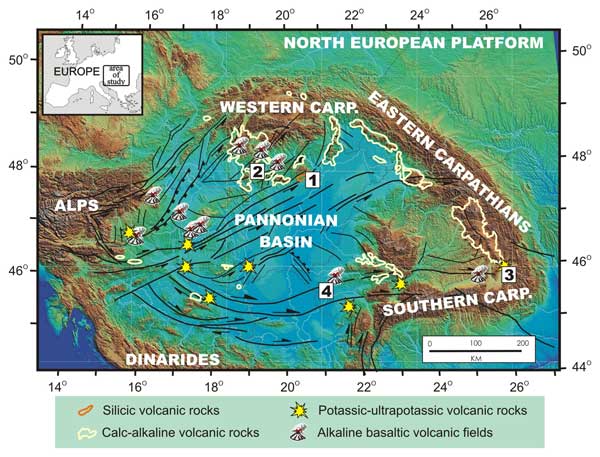
Figure 1: Neogene to
Quaternary volcanic rocks in the Carpathian-Pannonian
region (only those that outcrop are shown).
Localities mentioned in the text: 1. Southern foreland
of the Bükk Mts. (Miocene
silicic ignimbrites); 2. Northern Pannonian basin (Miocene
to Quaternary calc-alkaline and alkaline volcanic rocks);
3. Ciomadul (K-dacite; location of the last volcanic
eruption of the CPR); 4. Lucaret (2.5-Ma-old alkali
basalt).
The nature of the upper mantle beneath
the CPR is inferred from seismic tomographic models.
These show a high-velocity body in the transition zone
(400-670 km) interpreted as accumulated subducted slab
material (Wortel & Spakman, 2000; Piromallo & Morelli,
2003; Hetényi et al., 2009), a near-vertical
high-velocity slab beneath the southeastern margin
of the CPR (Vrancea zone), regarded as the trace of
final-stage subduction (Sperner et al.,
2001; 2004) and relatively low velocity material between
the transition zone and the base of lithosphere.
Classification and temporal evolution of the Neogene
to Quaternary volcanic rocks
The complex geodynamic evolution of
the CPR involved the formation of a wide range of magmatic
rocks over the last 20 Ma (Szabó et al.,
1992; Lexa & Konecný,
1998; Harangi, 2001; Seghedi et al.,
2004b; 2005; Harangi & Lenkey,
2007).
They can be divided into the following
main groups based on their geochemistry (Harangi,
2001):
- Miocene (21-13 Ma) silicic pyroclastic rocks;
- Middle Miocene to Quaternary (16.5-2 Ma) calc-alkaline
volcanic rocks;
- Miocene and Quaternary (15-13 Ma and 2-0.02 Ma)
potassic and ultrapotassic rocks;
- Late Miocene to Quaternary (11-0.2 Ma) alkaline
sodic volcanic rocks (Figure 1).
In the following, I give a brief summary of the genesis
of these four volcanic groups.
Miocene (21-13 Ma) silicic volcanism
This volcanism resulted mostly in
extensive ignimbrite sheets. Effusive rocks have not
been found. At the southern foot of the Bükk Mts.
(Northern Hungary), fresh Miocene silicic ignimbrites
are preserved and therefore provide an excellent opportunity
for detailed investigations (Harangi et al.,
2005; Lukács,
2009). All the pumices have silicic (> 65 wt% SiO2)
composition, whereas the scoriae and the cognate lithic
clasts are mostly andesites (Figure 2).
Thus, this volcanism seems to reflect a bimodal (andesitic-rhyolitic)
composition with a significant gap between the compositions.
A detailed mineral-scale investigation (Lukács,
2009) has revealed, however, that the bulk composition
of the lithic clasts does not necessarily represent
an andesitic magma having a role in magma evolution.
These fragments, which could derive from different
parts of the crystal mush zone of the silicic magma
reservoir, contain disequilibrium mineral assemblages
(plagioclases with 40-90 mol% An-content and orthopyroxenes
with 50-85 mol% En-content) sitting in a rhyolitic
glassy matrix, which resembles the composition of the
glass shards in the ignimbrite. The most striking observation
is the finding of magnesian orthopyroxenes in these
rocks (Lukács, 2009). They clearly
suggest the role of mafic magmas with fairly primitive
(Mg# > 0.6) composition. These mantle-derived mafic
magmas contributed significantly to the evolution of
the shallow-level silicic magma reservoirs. Therefore,
the Miocene silicic volcanism of the CPR might be intracontinental
bimodal basalt-rhyolite style, even though no basaltic
magmas erupted along with the rhyolitic ignimbrites.
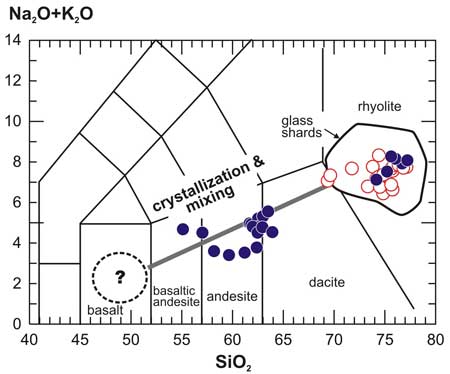
Figure 2: Major-element data of
the pumices (open circles) and the scoriae and cognate
lithic clasts (filled circles; after Lukács,
2009). Composition of the glass shards representing
the fragmented melt is also shown. The andesitic chemistry
of the lithic clasts and scoriae does not mean that
andesitic magma participated in the magma evolution.
Instead, it reflects mixing of various mineral phases,
including those crystallized from mantle-derived mafic
magmas, and silicic residual melt.
The early-stage pumices have a strong
crustal component (87Sr/86Sr=
0.7010-0.7012; Harangi,
2001; Seghedi
et al.,
2004b). However, the isotopic composition
of their cognate “andesitic” lithic clasts
(87Sr/86Sr = 0.7068-0.7090) indicates
also the role of mantle-derived magmas. Thus, mixing
of magmas from the mantle and from the lower crust
is inferred in their genesis. Silicic volcanism lasted
for 8 Ma with repetitive explosive eruptions. The initial 87Sr/86Sr
isotope ratio of the pumices decreases, while the 143Nd/144Nd
isotope ratio increases with time (Figure 3),
implying a decreasing crustal component in their evolution.
This is consistent with a gradually thinning continental
plate and a geodynamic relationship between lithospheric
extension and silicic volcanism.
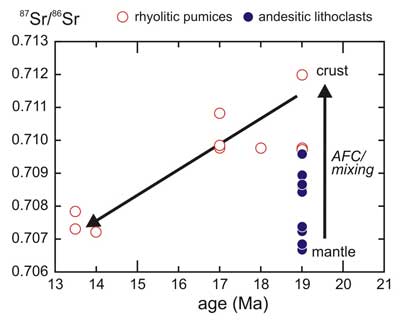
Figure 3: A temporal decrease in
the initial 87Sr/86Sr isotope
ratios of the rhyolitic pumices implies decreasing
crustal involvement, which could be consistent with
a gradually thinning lithosphere. The wide isotopic
composition in the initial rhyolitic volcanic products
can be explained as volcanism triggered by mafic
mantle-derived magmas.
Middle Miocene to Quaternary (16.5-2 Ma) calc-alkaline
volcanism
One of the most striking features of the Neogene to
Quaternary volcanism in the CPR is the development
of andesite-dacite volcanic complexes roughly parallel
to the Carpathian mountain chain (Figure 1).
This spatial distribution, as well as the calc-alkaline
character and the subduction-related trace-element
signature of the volcanic products (Mason et al.,
1996; Seghedi et al.,
2004b; Harangi et
al.,
2007) could be simply explained by a relationship
with coeval subduction process (Szabó et
al., 1992; Downes et al., 1995). Indeed,
it is supported by many geological and geophysical
models (e.g., Royden et al., 1982; Tomek & Hall,
1993; Tasarová et al., 2009). However,
alternative explanations are proliferating (Knapp
et al., 2005; Grad et al., 2006; Houseman & Gemmer,
2007), which argue against the traditional view of
a significant role of subduction.
Some observations imply no direct
relationship between the calc-alkaline volcanism and
active subduction. The volcanic complexes along the
northern part of the Pannonian basin are underlain
by thin (< 100 km) lithosphere and crust, suggesting
that these areas underwent significant stretching during
the Middle Miocene, coeval with the 16.5-9 Ma volcanism.
Syn-extensional timing for volcanism is supported also
by structural and paleomagnetic studies (Nemcok & Lexa,
1990; Karátson et al., 2000; 2007).
In the eastern parts of the CPR, the volcanoes are
parallel to the Carpathians, extending only 50-100
km from the assumed suture zone, and at the southeasternmost
segment they developed even on flysch sediments considered
to represent the accretionary wedge. The volcanic activity
lasted from about 14 Ma until 2 Ma with a gradual southward
migration of the eruptions (Pécskay et al.,
1995). However, the volcanism postdated the supposed
active subduction, which is inferred to have finished
by about 12 Ma. Thus, the calc-alkaline volcanism can
be classified as post-collisional. While the origin
of these rocks were discussed by Mason
et al. (1996;
1998) and Seghedi et al. (2004b; 2005), I present here
a couple of significant observations regarding the
calc-alkaline volcanic rocks of the northern part of
the Pannonian basin (Figure 1). These
have implications about their origin and geodynamic
relationships. This region is a peculiar one, since
it is characterized by long (since 16.5 Ma) and varied
volcanic activity. The calc-alkaline volcanism (16.5-9
Ma) was followed by eruptions of alkaline mafic magmas
(6.5-0.13 Ma).
A unique feature of the early stage
(15-16.5 Ma) calc-alkaline volcanic products in this
segment is the relatively frequent occurrence of garnet
(almandine) in the andesites and dacites (Harangi
et al.,
2001). The presence
of primary Ca-bearing almandine in these volcanic rocks
suggests relatively rapid ascent of andesitic to rhyodacitic
host magmas from the lower crust. This could have been
promoted by a tensional stress field (regional extension).
Indeed, formation of the garnet-bearing calc-alkaline
volcanic rocks at the northern Pannonian basin was
coeval with the peak extension of the area and thus
these rocks may be a sign of a change of the stress
field from compression to extension.
A detailed description of the geochemical
features of the calc-alkaline volcanic rocks in the
northern Pannonian basin is provided by Harangi
et al. (2007).
A gradual change of magma composition can be observed, e.g.,
La/Nb, Th/Nb and 87Sr/86Sr ratios
decrease, whereas
143Nd/144Nd and 206Pb/204Pb
increase with time (Figure 4). In contrast, the Ba/La
and
207Pb/204Pb and 208Pb/204Pb isotope
ratios do not show any clear temporal change. This
compositional variation can be explained by a decreasing
crustal component in magmagenesis and/or
an increasing role of enriched asthenospheric mantle.
In addition, a change in the mantle source, i.e. from
metasomatized, slightly enriched MORB source mantle
to a more enriched, OIB-source mantle can be also
inferred at about 13-14 Ma (Figure 5). The appearance
of the OIB-like, enriched mantle component in the late-stage
calc-alkaline volcanism can be explained by various
models as discussed by Harangi
et al. (2007). The most plausible one is the progressive
thinning of the continental lithosphere with a change
in the mantle source region from metasomatized lithospheric
mantle to passively upwelling asthenosphere. In this
scenario the early-stage (14-16 Ma) magmatism is a
sign of the initiation of lithospheric thinning when
partial melting took place in the lower part of the
lithosphere metasomatized by earlier subduction. The
mafic magmas may have ponded beneath the thick continental
crust resulting in melting of the lower crust. As lithospheric
extension progressed, the crustal component decreased
and the mantle source changed to a sublithospheric
one.
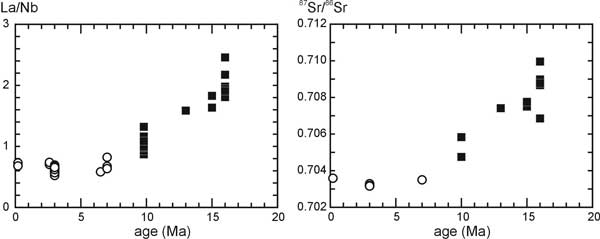
Figure 4: Temporal variation of the
La/Nb trace-element ratio and initial 87Sr/86Sr isotopes
in the calc-alkaline (filled squares) and alkaline
(open circles) volcanic rocks of the Northern Pannonian
Basin. Note the gradual temporal change in geochemical
composition.
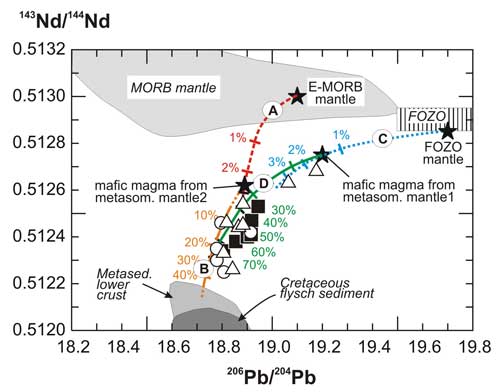
Figure 5: A two-stage model for the
genesis of the calc-alkaline rocks of the northern
Pannonian basin (Harangi
et al., 2007) based on the
variation of 143Nd/144Nd (sensitive
to involvement of a crustal component) and 206Pb/204Pb (sensitive
to the type of mantle component) isotope ratios. Model
parameters are given in Harangi
et al. (2007). The
preferred model involves an E-MORB-source mantle, which
was contaminated by 2-3% subducted sediment (mixing
line ’A’). The mafic melt formed
from this metasomatized mantle source (metasomatized
mantle2) subsequently mixed with the lower crustal
material (mixing line ’B’). This scenario
could be applicable to the older (>15 Ma) magmatism,
but does not explain the genesis of the <15 Ma magmas.
For this, a sharp change in composition of the mantle
source is needed, i.e. from an E-MORB-type to a FOZO-type
mantle. The isotopic variation of the post-15 Ma magmas
can be explained by modification of a FOZO-like, enriched
mantle by 1-2% subducted sedimentary component (trend
C; resulting in metasomatized mantle1) followed by
mixing of mafic melt derived from this metasomatized
mantle with silicic melt from the metasedimentary lower
crust (trend D).
The supposed OIB-type mantle source
has an isotopic character similar to FOZO as defined
by Stracke
et al. (2005) or to the common European Asthenospheric
Reservoir (EAR; Cebriá & Wilson,
1995; Hoernle et al., 1995; Lustrino & Wilson,
2007). A plume origin of this mantle component is unlikely
in the Pannonian Basin (Harangi & Lenkey,
2007). Instead, it could reside in the shallow asthenosphere
and possibly also in the lower lithosphere causing
small-scale heterogeneity (Rosenbaum et al.,
1997). Transition from calc-alkaline to alkaline magmatism
is observed in many parts of the Mediterranean region
(Wilson & Bianchini, 1999). In the northern
Pannonian basin, this transition does not necessarily
indicate a change in the geodynamic setting, i.e. from
subduction to extension. Instead, both types of magmatism
were somehow related to lithospheric extension. Calc-alkaline
magmas were generated during the period of peak extension,
by melting of metasomatized lithospheric mantle, and
were contaminated by various crustal materials, whereas
the alkaline mafic magmas formed during the post-extensional
stage by low-degree melting of the shallow heterogeneous
asthenosphere.
Miocene and Quaternary (15-13 Ma and 2-0.02 Ma)
potassic and ultrapotassic rocks
Potassic and ultrapotassic rocks occur
sporadically in the CPR (Harangi et al., 1995).
Some of them were formed during the Middle Miocene
(13-15 Ma; Harangi
et al., 1995) and therefore their origin could
be explained by thinning of the lithosphere and, as
a consequence, decompression melting of their strongly
metasomatized lower parts. Later, there was a second
pulse of potassic-ultrapotassic volcanism in the Quaternary
(< 2 Ma). Remarkably, these volcanic eruptions occurred
along a west-east trending zone at the south-southeast
margin of the Pannonian basin (Figure 1).
The last volcanic eruption of the CPR involved the
formation of K-rich dacites at 30 ka (Ciomadul; SE-Carpathians).
The origin of this kind of volcanism
is still enigmatic. Since further lithospheric extension
is excluded during this period, a hot mantle upwelling
could be invoked as a possible mechanism to remobilize
the metasomatized mantle region (Ed: see also Anatolia).
The intermittent volcanic eruptions along as belt ~
600 km long, and the close relationship with major
tectonic lines, suggest, however, plate tectonic control.
For the last 5 Ma, the hot, thin and therefore weak
lithosphere has undergone tectonic reactivation related
to basin inversion (Cloetingh
et al.,
2005; Horváth & Cloetingh, 2006; Bada
et al., 2007). This implies changes in the regional
stress field from tension to compression resulting
in different, and in some cases kilometer-scale, vertical
movements. The consequence of the short- and long-wavelength
differential vertical movements for the mostly elastic
lower lithosphere and the underlying asthenosphere
is unclear, but it might have intermittently reactivated
mantle domains with low solidus.
Mafic magmas from the asthenosphere could also contribute
to this volcanism as revealed by detailed mineral-scale
investigation on the youngest volcanic rocks of the
CPR. The Mg-rich olivine (Fo-content is up to 90 mol%)
and/or orthopyroxene (Mg# ~ 0.9) and oscillatory zoned
clinopyroxenes (Mg# up to 0.92) suggest the role of
mafic magma with fairly primitive composition in the
genesis of the dacitic volcanism! Subcrustal seismic
attenuation has been detected beneath this region at
50-60 km depths that may indicate the presence of shallow,
hot asthenosphere, possibly with partially melted zones
(Popa et al., 2005; Russo et al.,
2005). Horizontal delamination of the lower lithosphere
(Gîrbacea & Frisch, 1998; Chalot-Prat & Gîrbacea,
2000) or toroidal flow at the narrow, downgoing plate
edge could initiate asthenospheric upwelling and decompression
melting. Some mafic magmas could pond beneath the thick
(40-45 km) crust and cause crustal melting.
Late Miocene to Quaternary (11-0.2 Ma) alkaline
sodic volcanic rocks
The origin of the alkaline basaltic
volcanism is still enigmatic since it occurred during
the post-rift thermal subsidence and the tectonic inversion
phases of the Pannonian basin (Ed: see also Orign
of OIB).
Its chemical compositions resemble Neogene alkaline
mafic rocks in Europe. Some of the basalts share the
EAR isotopic signature and thus one popular model for
their origin is a mantle plume (Embey-Isztin
et al., 2001; Seghedi
et al.,
2004a).
In the mid-1990s, integrated geochemical and
seismic studies led to the proposal that localized
mantle upwellings (‘mantle plume fingers’ or ‘baby-plumes’)
deriving from a common mantle reservoir (EAR; Cebria & Wilson,
1995) could be responsible for the volcanism in the
Massif Central, the Rhenish area, the Eger graben,
Bohemia and also in the Pannonian basin (Hoernle
et al., 1995; Granet et al., 1995). The
EAR component of these postulated plume fingers is
characterized by a HIMU- or FOZO-like isotopic composition.
Upwelling of a localized mantle plume beneath the Pannonian
Basin can explain the melt generation and volcanism
after the peak extension (Seghedi
et al.,
2004a),
and supporting geological, geochemical and geophysical
models have also been presented (Goes et al.,
1999; Buikin et al., 2005; Burov and Cloetingh,
2009). In contrast, Harangi & Lenkey (2007) argue
against a mantle plume beneath the Pannonian basin.
Here, I report further important observations, which
must be considered in this context.
The first observation is related to
the spatial distribution of the alkaline mafic volcanic
fields (Figure 6). They are located mostly at the west-northwestern
periphery of the Pannonian basin and not in the region
which underwent significant thinning and is characterized
by thin lithosphere (< 60 km in the central part
of the Pannonian basin). This peripheral area is underlain
by a lithosphere/asthenosphere boundary with a steep
gradient (from 110 to 70 km depths). Thus, most of
the basaltic volcanic fields are in transitional zones
between the orogenic Alps and cratonic North European
Platform areas with thick (> 160 km) lithospheric
roots and the stretched Pannonian basin with thin (< 70
km) lithosphere. The Pannonian basin could act as a
thin-spot providing suction in the sublithospheric
mantle and generating mantle flow from below the thick
lithospheric roots (Ed: see also Hydration
weakening).
This mantle flow will have a near-vertical component
along the steep lithosphere/asthenosphere boundary
that could lead to decompression melting (Figure 7). Lebedev
et al. (2006) explained
the hotspot-like basaltic volcanism in the Baikal rift
area by asthenospheric mantle flow from the cratonic
areas, which appears to be a very similar situation.
However, considering the lithospheric thickness variation
beneath the CPR, another scenario is possible. At the
northwestern margin of the CPR a subcontinental lithospheric
corridor may exist (Figure 6) that
might channel asthenospheric mantle towards the thin-spot
beneath the Pannonian basin. Preliminary seismic anisotropy
data appear to support this, since they show dominant
NW-SE directions (Stuart et al., 2007). However,
the consequence of this scenario is similar to the
former one, i.e. a subvertical component of a mantle
flow along the steep lithosphere/asthenosphere boundary
that leads to decompression melting. Nevertheless,
for this mechanism to work, the mantle must be able
to melt.
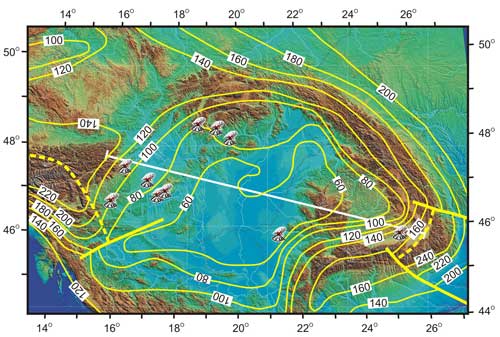
Figure 6: Distribution of the alkaline
basalt volcanic fields and contours of lithospheric
thickness (Horváth et al., 2006). Most of the
volcanic fields (and the most productive) lie
at the northwestern margins of the Pannonian basin,
and are underlain by a sharp change in the lithosphere/asthenosphere
boundary. The white line denotes the section shown
in Figure 7.
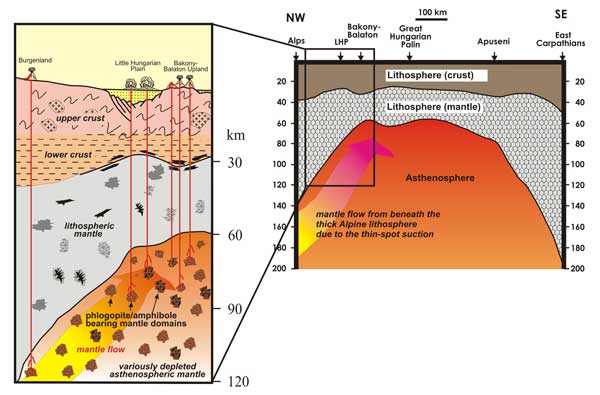
Figure 7: Suggested model for the origin
of the alkali basalt volcanism in the CPR. Melt generation
occurred as a result of mantle flow from the Alpine
regime which has a thick lithospheric root. This flow
has a subvertical component at the western-northwestern
margin of the Pannonian basin; resulting in melting
of the heterogeneous, variously fertile sublithospheric
mantle.
The chemical composition of the mafic
magmas indicates that melt generation could have occurred
mostly in the asthenosphere, in the garnet-peridotite
stability zone, i.e. > 80 km depth by 1-4% of melting.
Based on the trace-element signatures, Harangi & Lenkey (2007) distinguished two groups of basalts in the CPR. One
of the main differences between the two groups is the
occurrence of a negative K-anomaly in the primitive-mantle-normalized
multi-element diagram. The petrogenetic model calculations
suggest a K-bearing phase (either phlogopite or amphibole)
in the residue and variable degrees of melting of a
garnet-peridotite source (Harangi & Lenkey,
2007). However, investigating the basaltic volcanic
fields separately, a weak correlation can be observed
between the Sr-Nd isotopic ratios and the degree of
negative K-anomaly (K/K*; Figure 8).
This can be explained by mixing between an isotopically
more depleted mantle domain with K-bearing phase or
one with an inherited K-depletion and an isotopically
less depleted mantle domain with no K-bearing phase
or no K-depletion.
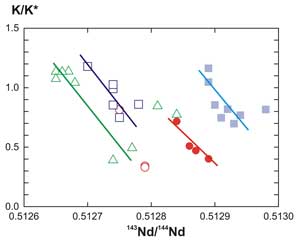
Figure 8: Correlation between the 143Nd/144Nd isotope
ratio and the degree of negative K-anomaly (K/K*)
in individual basalt volcanic field could indicate
heterogeneous mantle source regions.
The relatively wide compositional
variation of the alkaline mafic rocks in the CPR both
regionally and locally and the presence of the HIMU/FOZO-like
isotope and trace-element ratios in some of them are
consistent with a heterogeneous mantle model such as
marble-cake or a streaky mantle model (Allégre & Turcotte,
1986; Smith, 2005). The shallow asthenospheric
mantle could be heterogeneous on a relatively small-scale,
preserving fragments of subducted crust for a long
time (Meibom & Anderson, 2003; Kogiso
et al., 2004). Niu & O’Hara (2003)
suggested that metasomatized oceanic lithosphere portions
were important geochemical reservoirs, hosting volatiles
and with trace-element and isotopic characteristics
that resulted from earlier metasomatism. The long history
of orogenic events (Hercynian and Alpine) in Europe
could have supplied a vast amount of crustal material
into the upper mantle producing geochemical heterogeneity
on various scales. Partial melting of different parts
of the shallow asthenospheric mantle (metasomatized,
phlogopite-bearing sections with HIMU-like composition
and variously depleted mantle around them) and mixing
of these melts could explain the compositional variation
in the alkaline mafic magmas of the Pannonian Basin.
Additional implications for a small-scale
heterogeneous mantle source come from a recent
comprehensive study of the spinel chemistry of the
basalts. Spinels are among the first phases to crystallize
from basaltic magma and their compositions strongly
depend on the magma- and source compositions (Arai,
1992; Barnes & Roeder,
2001; Kamenetsky et al., 2001; Roeder
et al., 2003). They are commonly found in olivine
phenocrysts. Their compositions show a remarkably wide
variation in the Cr-Fe3+-Al plot (Figure
9). They can be divided into four separate groups,
presumably suggesting that four main mantle domains
are involved in the genesis of the mafic magmas. Two
groups fall into the field of MORB spinels and the
other two resemble spinels from OIB. The most striking
feature, however, is that spinels with distinct compositions
can be found even in single samples (Figure 9)!
Here, only the most extreme example is shown. The 2.5
Ma old alkali basalt from Lucaret (Figure 1) contains
spinels with a dominant population akin to OIB
spinels, whereas a subordinate group of spinels has
high Al-content and indicates a MORB-type mantle source.
This bimodal composition is exactly the same that found
by Paul et al. (2007) in the basaltic suite
of Mauritius, but with a special feature that here
it is found even in a single sample. Thus, it is supposed
that basaltic magmas could represent a mixture of mafic
melts occasionally coming from very different mantle
source domains (e.g., pyroxenitic/eclogitic
and peridotitic sources). This could have a strong
implication for the small-scale (possibly in a scale
of 102-103 m) heterogeneity of
the shallow asthenosphere.
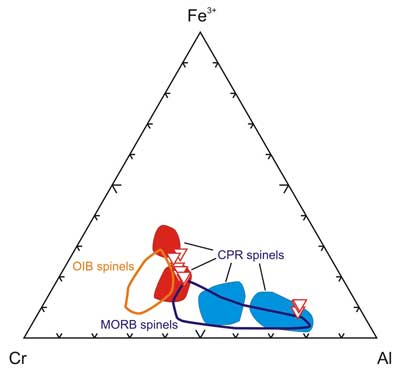
Figure 9: Composition
of spinels in the Cr-Fe3+-Al ternary diagram. OIB and
MORB spinels are after Roeder (1994). The spinel composition
from the CPR basalts forms four separate groups. The
Lucaret basalt contains bimodal spinel population (triangle)
suggesting involvement of magma batches derived from
different source region and small-scale heterogeneity
in the shallow asthenosphere.
Concluding remarks
Harangi & Lenkey (2007) pointed out that the lack of broad topographic updoming,
the high velocity body in the mantle transitional zone,
the sporadic distribution of the mafic volcanic fields
and the fairly low magma production rate are all inconsistent
with the plume theory in the CPR. The observations
presented here also suggest that a mantle plume beneath
the Pannonian basin is highly unlikely, and instead
I propose a possible mechanism for the origin of
the alkaline mafic volcanism. Extension of the lithosphere
played a major role in melt generation both directly
and indirectly. The sublithospheric shallow mantle
may be still close to its solidus as a consequence
of an earlier lithospheric extension event. This, along
with its heterogeneous, variously fertile nature implies
that the mantle may be still capable of producing
melt. Thus, further volcanic eruptions cannot be ruled
out, even in this seemingly quiescent part of Europe!
Acknowledgements
I would like to thank Gillian
Foulger for inviting and encouraging me to write
this overview. Her constructive remarks helped me
to focus on the main points and keep the text as
concise as possible. The results presented here come
from many beneficial discussions with Theo Ntaflos,
Nino Seghedi, Hilary Downes, Réka Lukács,
Balázs Kiss, Éva Jankovics, Tomi Sági,
Paul Mason, Laci Lenkey, Gábor Bada, Laci Fodor,
Frank Horváth and Endre Dombrádi. The
enthusiastic research work of my students in the Volcanology
Group on different areas of the Neogene volcanism of
the CPR has provided me with continuous inspiration
to search for what lies behind the observations and
how to describe and understand the beauty of Nature.
References
-
Allegre, C., and Turcotte, D.L., 1986, Implications
of a two-component marble-cake mantle. Nature, 323,
123-127.
-
Arai, S., 1992, Chemistry of chromian spinel
in volcanic rocks as a potential guide to magma chemistry. Mineralogical
Magazine, 56, 173–184.
-
Bada,
G., Horváth, F., Dövényi,
P., Szafián, P., Windhoffer, G., and Cloetingh,
S., 2007, Present-day stress field and tectonic
inversion in the Pannonian basin. Global and
Planetary Change, 58,
165-180.
-
Barnes, S.J., and Roeder, P.L., 2001, The Range
of Spinel Compositions in Terrestrial Mafic and Ultramafic
Rocks. J. Petrology, 42,
2279-2302.
-
Buikin, A., Trieloff, M., Hopp,
J., Althaus, T., Korochantseva, E., Schwarz, W.H.,
and Altherr, R., 2005, Noble gas isotopes suggest
deep mantle plume source of late Cenozoic mafic
alkaline volcanism in Europe. Earth and Planetary
Science Letters, 230, 143-162.
-
Burov,
E., and Cloetingh, S., 2009, Controls of mantle
plumes and lithospheric folding on modes of intraplate
continental tectonics: differences and similarities. Geophysical
Journal International, 178,
1691 - 1722.
-
Burov, E., Guillou-Frottier,
L., d'Acremont, E., Le Pourhiet, L., and Cloetingh,
S., 2007, Plume head–lithosphere
interactions near intra-continental plate boundaries. Tectonophysics, 434,
15-38.
-
Cebriá, J.M., and Wilson,
M., 1995, Cenozoic mafic magmatism in western/central
Europe: A common European asthenospheric reservoir? Terra Nova, 7,
162.
-
Chalot-Prat, F., and Girbacea,
R., 2000, Partial delamination of continental mantle
lithosphere, uplift-related crust-mantle decoupling,
volcanism and basin formation: a new model for
the Pliocene-Quaternary evolution of the southern
East-Carpathians, Romania. Tectonophysics, 327,
83-107.
-
Cloetingh, S., Matenco, L.,
Bada, G., Dinu, C., and Mocanu, V., 2005, The evolution
of the Carpathians–Pannonian
system: Interaction between neotectonics, deep
structure, polyphase orogeny and sedimentary basins
in a source to sink natural laboratory. Tectonophysics, 410,
1-14.
-
Downes, H., Pantó, G., Póka,
T., Mattey, D., and Greenwood, B., 1995, Calc-alkaline
volcanics of the Inner Carpathian arc, Northern
Hungary: new geochemical and oxygen isotopic results. Acta
Vulcanologica, 7,
29-41.
-
Embey-Isztin, A., Downes, H., and Dobosi, G.,
2004, Geochemical characterization of the Pannonian
Basin mantle lithosphere. Acta Geologica Hungarica, 44,
259–280.
-
Girbacea, R., and Frisch, W., 1998, Slab
in the wrong place: Lower lithospheric mantle delamination
in the last stage of Eastern Carpathians subduction
retreat. Geology, 26,
611-614.
-
Goes, S., Spakman, W., and Bijwaard, H., 1999,
A lower mantle source for central European volcanism. Science, 286,
1928-1931.
-
Grad, M., Guterch, A., Keller,
G.R., Janik, T., Hegedus, E., Voza?r, J., S?laczka,
A., and Tiira, T., 2006, Lithospheric structure
beneath trans-Carpathian transect from Precambrian
platform to Pannonian basin: CELEBRATION 2000 seismic
profile CEL05. Journal
of Geophysical Research B: Solid Earth, 111,
1-23.
-
Granet, M., Wilson, M., and
Achauer, U., 1995, Imaging a mantle plume beneath
the French Massif Central. Earth
and Planetary Science Letters, 136,
281-296.
-
Harangi, S., 2001, Neogene to
Quaternary Volcanism of the Carpathian-Pannonian
Region - a review. Acta
Geologica Hungarica, 44,
223-258.
-
Harangi,
S., Downes, H., Kósa, L., Szabó,
C., Thirlwall, M.F., Mason, P.R.D., and Mattey,
D., 2001, Almandine Garnet in Calc-alkaline Volcanic
Rocks of the Northern Pannonian Basin (Eastern-Central
Europe). Geochemistry, Petrogenesis and Geodynamic
Implications J.
Petrology, 42, 1813-1843.
-
Harangi,
S., and Lenkey, L., 2007, Genesis of the Neogene
to Quaternary volcanism in the Carpathian-Pannonian
region: Role of subduction, extension, and mantle
plume. in Beccaluva,
L., Bianchini, G., and Wilson, M., eds., Cenozoic
volcanism in the Mediterranean area. Geological
Society of America Special Paper, 418,
67-92.
-
Harangi, S., Downes, H, Thirlwall, M. and Gmeling,
K., Geochemistry, Petrogenesis and Geodynamic
Relationships of Miocene Calc-alkaline Volcanic Rocks
in the Western Carpathian Arc, Eastern Central Europe,
J. Pet., 48, 2261-2287,
2007.
-
-
Harangi, S., Wilson, M., and Tonarini, S.,
1995, Petrogenesis of Neogene potassic volcanic rocks
in the Pannonian Basin. Acta Vulcanologica, 7,
125-134.
-
Hetényi, G., Stuart, G.W., Houseman,
G.A., Horváth,
F., Hegedûs, E., and Brückl, E., 2009,
Anomalously deep mantle transition zone below Central
Europe: Evidence of lithospheric instability. Geophysical Research
Letters, 36, L21307, doi:10.1029/2009GL040171.
-
Hoernle,
K., Zhang, Y.S., and Graham, D., 1995, Seismic and
geochemical evidence for large-scale mantle upwelling
beneath the eastern Atlantic and western and central
Europe. Nature, 374, 34-39.
-
Horváth,
F., Bada, G., Szafián, P., Tari,
G., Ádám, A., and Cloetingh, S.,
2006, Formation and deformation of the Pannonian
basin: Constraints from observational data. in Gee,
D.G., and Stephenson, R.A., eds., European Lithosphere Dynamics,
Geological Society, London, Memoirs, 32,
191-206.
-
Horváth, F., and Cloetingh,
S., 1996, Stress-induced late-stage subsidence
anomalies in the Pannonian basin. Tectonophysics, 266,
287-300.
-
Houseman, G.A., and Gemmer, L., 2007, Intra-orogenic
extension driven by gravitational instability: Carpathian-Pannonian
orogeny. Geology, 35, 1135-1138.
-
Kamenetsky,
V.S., Crawford, A.J., and Meffre, S., 2001, Factors
Controlling Chemistry of Magmatic Spinel: an Empirical
Study of Associated Olivine, Cr-spinel and Melt Inclusions
from Primitive Rocks. J. Petrology, 42,
655-671.
-
Karátson, D., Márton, E., Harangi,
S., Józsa, S., Balogh, K., Pécskay, Z.,
Kovácsvölgyi,
S., Szakmány, G., and Dulai, A., 2000, Volcanic
evolution and stratigraphy of the Miocene Börzsöny
Mountains, Hungary: an integrated study. Geologica
Carpathica, 51, 325-343.
-
Karátson,
D., Oláh, I., Pécskay,
Z., Márton, E., Harangi, S., Dulai, A., Zelenka,
T., and Kósik, S., 2007, Miocene volcanism in
the Visegrád Mountains (Hungary): an integrated
approach to regional volcanic stratigraphy. Geologica
Carpathica, 58, 541-563.
-
Knapp,
J.H., Knapp, C.C., Raileanu, V., Matenco, L., Mocanu,
V., and Dinu, C., 2005, Crustal constraints on
the origin of mantle seismicity in the Vrancea
Zone, Romania: The case for active continental
lithospheric delamination. Tectonophysics, 410,
311-323.
-
Kogiso, T., Hirschmann, M.M.,
and Reiners, P.W., 2004, Length scales of mantle
heterogeneities and their relationship to ocean
island basalt geochemistry. Geochimica
et Cosmochimica Acta, 68,
345-360.
-
Lebedev,
S., Meier, T., and van der Hilst, R.D., 2006, Asthenospheric
flow and origin of volcanism in the Baikal Rift
area. Earth & Planetary
Science Letters, 249, 415-424.
-
Lexa,
J., and Koneèný, V., 1998, Geodynamic
aspects of the Neogene to Quaternary volcanism. in Rakús,
M., ed., Geodynamic development of the Western
Carpathians. Bratislava, Geological Survey
of Slovak Republik, 219-240.
-
Lukács, R., 2009, Petrogenesis
of the Miocene silicic pyroclastic rocks of Bükkalja,
Northern Hungary: Inferences for the magma reservoir
processes: Budapest, Eötvös Loránd
University.
-
Lustrino, M., and Wilson, M.,
2007, The circum-Mediterranean anorogenic Cenozoic
igneous province. Earth-Science
Reviews, 81, 1-65.
-
Mason, P.R.D.,
Downes, H., Thirlwall, M.F., Seghedi, I., Szakács,
A., Lowry, D., and Mattey, D., 1996, Crustal assimilation
as a major petrogenetic process in east Carpathian
Neogene to Quaternary continental margin arc magmas. Journal
of Petrology, 37,
927-959.
-
Mason,
P.R.D., Seghedi, I., Szakács,
A., and Downes, H., 1998), Magmatic constraints
on geodynamic models of subduction in the Eastern
Carpathians, Romania. Tectonophysics, 297,
157-176.
-
Meibom, A., and Anderson, D.L.,
2003, The statistical upper mantle assemblage. Earth
and Planetary Science Letters, 217,
123-139.
-
Nemcok,
M., and Lexa, J., 1990, Evolution of the Basin and
Range structure around the Ziar Mountain Range. Geologica
Carpathica, 41, 229-258.
-
Niu,
Y., and O'Hara, M.J., 2003, Origin of ocean island
basalts: A new perspective from petrology, geochemistry,
and mineral physics considerations. Journal
of Geophysical Research, 108,
2209.
-
Paul, D.,
Kamenetsky, V.S., Hofmann, A.W., and Stracke, A.,
2007, Compositional diversity among primitive lavas
of Mauritius, Indian Ocean: Implications for mantle
sources. Journal
of Volcanology and Geothermal Research, 164,
76-94.
-
Pécskay, Z., Edelstein,
O., Seghedi, I., Szakacs, A., Kovacs, M., Crihan,
M., and Bernad, A., 1995, K-Ar datings of Neogene-Quaternary
calc-alkaline volcanic rocks in Romania. Acta Vulcanologica, 7,
53-61.
-
Piromallo, C., and Morelli, A., 2003, P wave
tomography of the mantle under the Alpine-Mediterranean
area. Journal
of Geophysical Research, 108,
2065, doi:10.1029/2002JB001757.
-
Popa, M., Radulian,
M., Grecu, B., Popescu, E., and Placinta, A.O.,
2005, Attenuation in Southeastern Carpathians area:
Result of upper mantle inhomogeneity. Tectonophysics, 410,
235-249.
-
Roeder, P.L., 1994, Chromite: from the fiery
rain of chondrules to the Kilauea Iki lava lake. Canadian
Mineralogist, 32, 729–746.
-
Roeder,
P.L., Thornber, C., Poustovetov, A., and Grant,
A., 2003, Morphology and composition of spinel
in Pu’u ’O’o
lava (1996–1998), Kilauea volcano, Hawaii. Journal
of Volcanology and Geothermal Research, 123,
245-265.
-
Rosenbaum, J.M., Wilson, M.,
and Downes, H., 1997, Multiple enrichment of the
Carpathian-Pannonian mantle: Pb-Sr-Nd isotope and
trace element constraints. Journal
of Geophysical Research, 102,
14,947–14,962.
-
Royden, L.H., Horváth,
F., and Burchfiel, B.C., 1982, Transform faulting,
extension and subduction in the Carpathian-Pannonian
region. Geological
Society of America Bullettin, 93,
717-725.
-
Russo, R.M., Mocanu, V., Radulian, M., Popa,
M., and Bonjer, K.-P., 2005, Seismic attenuation
in the Carpathian bend zone and surroundings Earth
and Planetary Science Letters, 237,
695-709.
-
Seghedi, I., Downes, H., Harangi, S., Mason,
P.R.D., and Pecskay, Z., 2005, Geochemical response
of magmas to Neogene-Quaternary continental collision
in the Carpathian-Pannonian region: A review Tectonophysics, 410,
485-499.
-
Seghedi, I., Downes, H., Szakacs,
A., Mason, P.R.D., Thirlwall, M.F., Rosu, E., Pecskay,
Z., Marton, E., and Panaiotu, C., 2004b, Neogene-Quaternary
magmatism and geodynamics in the Carpathian-Pannonian
region: a synthesis. Lithos, 72,
117-146.
-
Seghedi,
I., Downes, H., Vaselli, O., Szakacs, A., Balogh,
K., and Pecskay, Z., 2004a, Post-collisional Tertiary-Quaternary
mafic alkalic magmatism in the Carpathian-Pannonian
region: a review. Tectonophysics, 393,
43-62.
-
Smith, A.D., 2005, The streaky mantle alternative
to mantle plume and its bearing on Bulk Earth geochemical
evolution. in Foulger, G.R., Natland,
J.H., Presnall, D.C., and Anderson, D.L., eds., Plates,
Plumes and Paradigms, Geological Society of
America Special Papers, 388.
-
Sperner, B., Ioane, D., and
Lillie, R.J., 2004, Slab behaviour and its surface
expression: New insights from gravity modelling
in the SE-Carpathians. Tectonophysics, 382,
51-84.
-
Sperner, B., Lorenz, F., Bonjer, K., Hettel,
S., Muller, B., and Wenzel, F., 2001, Slab break-off
- abrupt cut or gradual detachment? New insights
from the Vrancea Region (SE Carpathians, Romania). Terra
Nova, 13,
172-179.
-
Stracke, A., Hofmann, A.W., and Hart, S.R.,
2005, FOZO, HIMU, and the rest of the mantle zoo. Geochemistry,
Geophysics, Geosystems, 6,
Q05007.
-
Stuart,
G.W., Houseman, G., Dando, B., Hegedûs,
E., Brueckl, E., Radovanovic, S., Falus, G., Kovács,
A., Hausmann, H., and Brisbourne, A., 2007, Understanding
Extension Within a Convergent Orogen: Initial Results
From the Carpathian Basins Seismic Project. American
Geophysical Union, Fall Meeting 2007, abstract
#S41A-0235.
-
Szabo,
C., Harangi, S., and Csontos, L., 1992, Review
of Neogene and Quaternary volcanism of the Carpathian-Pannonian
region. Tectonophysics, 208,
243-256.
-
Tašárová, A., Afonso,
J.C., Bielik, M., Götze, H.-J., and Hók,
J., 2009, The lithospheric structure of the Western
Carpathian–Pannonian
Basin region based on the CELEBRATION 2000 seismic
experiment and gravity modelling. Tectonophysics, 475,
454-469.
-
Tomek, C., and Hall, J., 1993,
Subducted continental margin image din the Carpathians
of Czechoslovakia. Geology, 21,
535-538.
-
Wilson, M., and Bianchini, G., 1999, Tertiary-Quaternary
magmatism within the Mediterranean and surrounding
regions. in Durand, B., Jolivet,
L., Horváth, F., and Séranne, M.,
eds., The
Mediterranean Basins: Tertiary extension within the
Alpine orogen. - Geological Society London
Special Publication, 156, 141-168.
-
Wortel,
M.J.R., and Spakman, W., 2000, Subduction and slab
detachment in the Mediterranean-Carpathian Region. Science, 290,
1910-1917.
last updated 30th
December, 2009 |
